calsfoundation@cals.org
Poultry Industry
A staple of the state’s economy, the Arkansas poultry industry first emerged in the 1890s. A century later, Tyson Foods, based in Springdale (Washington and Benton Counties), had become one of the largest agribusiness firms in the United States. Northwestern Arkansas, particularly Washington and Benton counties, produces the majority of poultry in Arkansas. The topography of the Ozark highlands—in contrast to the relatively flat eastern half of the state—is well suited to raising chickens. The hilly terrain has historically prevented the widespread cultivation of rice and cotton, which led northwestern Arkansas farmers to pursue interests in timber, fruit orchards, and especially poultry. By the early twenty-first century, poultry production had become an essential component of Arkansas’s economy, and Tyson Foods—with plants and products in over eighty countries—is currently one of the largest producers of food in the world, with annual revenues in the billions of dollars.
In 1893, Millard Berry of Springdale acquired an incubator with the intent of raising chickens on a large scale. By 1897, he was a founding member of a newly formed association, Arkansas Poultry Breeders. In 1908, Arkansas Agriculture Experiment Station began holding demonstrations on the modern techniques of poultry husbandry. Writing in journals such as Farm Poultry, W. S. Jacobs stressed the need for innovations which would ultimately be crucial in the development of the state’s poultry production: for instance, the importance of selecting high-quality fowl and the proper location of chicken houses. Despite improvements, in these years raising chickens was, for most Arkansas farmers, still supplemental economic activity, not a prime source of income.
In January 1914, Aaron Poultry and Egg Company (a subsidiary of meat-packing giant Armour) arrived in Fayetteville (Washington County), seeking people who were interested in raising chickens. Most farmers chose to remain focused on growing apples, beans, and tomatoes, but gradually a number of locals began producing poultry. In 1915, two prominent Fayetteville businessmen, Jay Fulbright and Richard Clark, began to ship poultry out of Arkansas. They quickly recognized the need for technological innovations in production in order for the state to become a viable source of quality birds.
In 1916, John J. Glover of Cave Springs (Benton County) purchased by mail several hundred high-quality White Wyandotte chickens. From this initial stock, he and his daughter Edith Glover Bagby started selling broilers—whole chickens—for one dollar per bird. Dubbed “Arkansas Broilers,” they were soon sought after for their tenderness and large size. By the early 1920s, chicken houses dotted the Ozark landscape. In 1924, Hugh Webb of Pea Ridge (Benton County) built a structure large enough to house 500 chickens. While Webb and others found a measure of success and self-sufficiency in this emergent field, many other poultry producers realized that raising birds in high-density conditions created several problems. In particular, high mortality rates resulted from a variety of diseases. Additionally, farmers suffered from frequent market fluctuations, as prices swung wildly and would continue to do so for decades. Moreover, Arkansas’s poor road conditions caused unforeseen expenses as well. This was alleviated somewhat after 1926, with the completion of Highway 71, which connected northwest Arkansas poultry producers to markets in Kansas City and beyond.
In 1927, a severe drought devastated northwest Arkansas’s fruit industry, spurring many farmers to begin raising chickens. Shelby Ford of Springdale, a local banker, extended credit to people who needed capital to purchase chicks and feed. In the cash-strapped 1920s, Ford, known locally as “the chicken banker,” played a critical role in encouraging the nascent poultry industry’s development. Another important figure was Jeff Brown, a hatchery owner and pioneer in the field of chicken feed.
By 1930, Charles George, a commercial hauler who made frequent trips from northwest Arkansas to St. Louis, started a hatchery to supply eggs to neighboring producers. By 1938, Willis Shaw of Elm Springs (Washington and Benton counties) formed a trucking business (now Willis Shaw Logistics) that brought broilers to markets in the Midwest. Shaw, along with Johnnie B. Hunt of Lowell (Benton County), would become leaders in the commercial trucking business. Indeed, the rise of Arkansas’s trucking firms coincided with, and reinforced, the developing poultry industry.
During the economic depression of the 1930s, Arkansas’s poultry producers escaped the Dust Bowl—which devastated surrounding areas—relatively unscathed. While the rest of the state’s economy suffered throughout the decade, the poultry industry underwent sustained growth. However, most chicken houses were still makeshift structures, and farmers often possessed only a basic knowledge of animal husbandry; nonetheless, producers such as Herman W. Greathouse of Washington County proved to be exceptions to this. In 1938, Greathouse owned nineteen chicken houses and shipped over 8,000 broilers per year. Along with Greathouse, Edward B. Crain of Springdale pioneered improvements in breeding, insisting on constant inspection and disease control. Production also increased because Agricultural Extension agents instituted the “Live-At-Home” program, which encouraged farmers to grow their own eggs and feed. This marked the beginning of a new phase in the state’s poultry industry, in which producers began the task of vertical integration.
Springdale-based trucker John Tyson, who settled in the area in 1931, was instrumental in this process. By 1936, he began hauling broilers to Kansas City and Chicago. Soon after this, he started raising his own flock. Shipping broilers himself, Tyson quickly emerged as a leader in the state’s rapidly growing poultry industry. From 1935 to 1940, Arkansas witnessed a 500 percent increase in the number of chicken producers. The industry received a boost during World War II, as poultry escaped government rationing. In 1943, Tyson initiated vertical integration of his company by raising his own chicks and feed. During the late 1940s, major food producers such as Armour, Swift, and Campbell’s Soup began locating poultry processing plants in northwest Arkansas. By 1950, nineteen plants were located in Springdale alone. Chickens were raised and slaughtered locally, packed in ice, and then shipped to markets. Plus Poultry had set up shop in Decatur (Benton County) in 1949 but relocated just a few years later to Siloam Springs (Benton County), where it was eventually renamed Simmons Foods after company co-founder M. H. “Bill” Simmons.
In the 1950s, still frustrated by market uncertainty, independent poultry farmers began to form associations, lobby groups, and co-ops. By mid-decade, poultry had become the state’s second-largest source of agricultural income, trailing only cotton. Leading the way was the Tyson firm, which by the early 1960s was fully integrated, as companies like Tyson controlled virtually every aspect of production, from hatchery to retail sales of broilers. Tyson built its first processing plant in 1958. John Tyson’s son Don, who would eventually lead the firm during its most expansive period, quit his studies at the University of Arkansas (UA) in Fayetteville in the early 1950s in order to learn the business firsthand. In 1963, the company made an initial public offering of its stock and also changed its name to Tyson’s Foods (eventually the firm was renamed Tyson Foods). Later that year, the company made its first major acquisition, buying Garrett Poultry of Rogers (Benton County). In 1966, Don Tyson was named president of the firm. Under his leadership, Tyson Foods continued buying competing firms and greatly expanded its product line.
In 1968, Tyson Foods opened retail outlets known as “Chicken Huts,” but this foray into marketing directly to consumers would eventually be discontinued. Nevertheless, by 1970, Tyson had emerged as a national leader in broiler sales, with annual gross revenue for that year exceeding $70 million. Tyson, along with in-state competitors ConAgra and Pilgrim’s Pride, eventually propelled Arkansas into becoming the nation’s number-one poultry producer. In 1982, Tyson Foods made the Fortune 500 list for the first time.
While the 1970s had been rough for the industry as prices fluctuated due to increased international competition and high domestic production, the 1980s witnessed unabated growth in the state’s poultry industry. Tyson Foods continued buying competing firms, while also securing lucrative contracts to supply chicken nuggets to restaurants such as fast-food giant McDonald’s. The industry itself changed dramatically during these years. As major producers continued to consolidate and merge, independent poultry farmers found their negotiating power with large firms gradually diminishing. Attempts at increasing their leverage through the formation of associations and co-ops did little to stem this tide, and many farmers began to worry that their profit margins—which typically remained small even for major firms—were steadily on the decline. As such, during the 1980s, the number of independent poultry farms in Arkansas decreased from over 6,000 in 1980 to roughly 1,200 a decade later.
The other major development affecting the poultry industry in this period occurred in the major processing plants, as Tyson and other large firms—long resistant to organized labor, as were most New South industries—began recruiting immigrant laborers from Latin America and the Marshall Islands as a source of cheaper labor, as well as to combat the problem of high employee turnover. This initiated a demographic shift in Arkansas, as communities such as Berryville (Carroll County) and Decatur, to name just two, absorbed an increasing number of foreign-born workers. Poultry processing plant wages remained lower than those of most factory jobs, and working conditions grew increasingly dangerous as production increased. This created a high rate of annual employee turnover—as much as 100 percent in some plants. Despite such trends, large processing firms enjoyed a steady supply of labor. While the influx of immigrant workers often strained local infrastructure, it also contributed to the steady growth of the state’s poultry industry. Foreign-born laborers had been working processing plants as far back as the early 1960s—particularly from Asia—but the wave of immigrants to the state did not begin in earnest until the mid-1980s.
Although one of the Arkansas’s major economic success stories, the poultry industry faced several challenges by the close of the 1990s, particularly with regard to labor disputes in its processing plants and environmental concerns stemming from the problem of poultry-waste runoff. For example, the State of Oklahoma regularly blamed Arkansas poultry producers and other urbanized industries across the border for the poor water quality of the Illinois River. The Wild and Scenic Rivers Act of 1993 sought in part to mediate concerns of pollution and water quality on both sides of the Oklahoma-Arkansas border, but in August 2005, Oklahoma attorney general Drew Edmondson levied a $30 million lawsuit on behalf of the state of Oklahoma against the sixteen poultry production companies headquartered in northwestern Arkansas. In 2018, as litigation was ongoing, Arkansas and Oklahoma signed an agreement committing the concerned government agencies in each state to collaborate on developing a watershed improvement plan, as well as sharing data. On January 18, 2023, the U.S. District Court in Tulsa finally ruled on the original 2005 lawsuit, deciding in favor of Oklahoma against Arkansas poultry producers. Tracking environmental contamination by poultry producers remains challenging, given that the Arkansas General Assembly, in 2003, passed Act 1059, which makes, in part, state records relating to the location of chicken houses inaccessible to the public via the Arkansas Freedom of Information Act.
In the beginning of the twenty-first century, the Arkansas poultry industry faced new challenges. The specter of a global avian influenza pandemic caused industry leaders to take strong measures to prevent an outbreak that might seriously damage U.S. poultry production. During the early days of the COVID-19 pandemic in the United States, Tyson Foods facilities across the country reportedly forced workers to labor even while sick. While some of the more notorious cases of such occurred outside of Arkansas, outbreaks at Tyson facilities in northwestern Arkansas drew even the attention of the New York Times. In March 2023, thirty-four Tyson Foods employees, former employees, and family members filed suit against the company in Pulaski County Circuit Court alleging that negligence during the pandemic led to death, injury, and emotional distress. Later that year, the U.S. Department of Labor announced that it was investigating allegations of child labor in meatpacking plants operated by Arkansas-based Tyson Foods and Perdue Farms following a September 18, 2023, New York Times Magazine story about Central American children working, and being grievously injured, at plants in Virginia.
For additional information:
Dowdy, Nancy Patrice. “J. K. Southerland: From Check-R-Mix to Fancy Pack, Pioneering the Poultry Industry in North Central Arkansas.” PhD diss., Arkansas State University, 2015.
Gray, LaGuana. “‘Arkansas’s First Boomtown’: El Dorado and the Emergence of the Poultry Processing Industry.” Arkansas Historical Quarterly 72 (Autumn 2013): 197–221.
———. We Just Keep Running the Line: Black Southern Women and the Poultry Processing Industry. Baton Rouge: Louisiana State University Press, 2014.
Hennigan, Mary, Abby Zimmardi and Rachell Sanchez-Smith. “At Least 9,000 Arkansas Workers Caught COVID-19 as Pandemic Overwhelmed Regulators, Companies.” Howard Center for Investigative Journalist, May 12, 2021. https://cnsmaryland.org/2021/05/12/at-least-9000-arkansas-workers-caught-covid-19-as-pandemic-overwhelmed-regulators-companies/ (accessed September 2, 2021).
Hickey, Jordan P. “Chicken Farms Hide in Plain Sight under Arkansas Law.” Arkansas Advocate, March 6, 2023. https://arkansasadvocate.com/2023/03/06/chicken-farms-hide-in-plain-sight-under-arkansas-law/ (accessed March 13, 2023).
Lakhani, Nina. “‘They Rake in Profits—Everyone Else Suffers’: US Workers Lose out as Big Chicken Gets Bigger.” The Guardian, August 11, 2021. Online at https://www.theguardian.com/environment/2021/aug/11/tyson-chicken-indsutry-arkansas-poultry-monopoly (accessed August 11, 2021).
Mohl, Raymond A. “Globalization, Latinization, and the Nuevo New South.” Journal of American Ethnic History 22 (Summer 2003): 31–66.
Paschal, Olivia. “COVID-19 Pounded Arkansas Poultry Workers as Government and Industry Looked On.” Facing South, August 21, 2020. https://www.facingsouth.org/2020/08/covid-19-pounded-arkansas-poultry-workers-government-and-industry-looked (accessed July 15, 2021).
———. “Dead Chicken Pileup Shows Poultry Growers’ Vulnerability to Government and Industry Power.” Arkansas Times, January 4, 2024. https://arktimes.com/arkansas-blog/2024/01/04/dead-chicken-pileup-shows-poultry-growers-vulnerability-to-government-and-industry-power (accessed January 4, 2024).
Riffel, Brent. “The Feathered Kingdom: Tyson Foods and the Transformation of American Land, Labor, and Law, 1930–2005.” Ph.D. diss., University of Arkansas, 2008.
Schwartz, Marvin. Tyson: From Farm to Market. Fayetteville: University of Arkansas Press, 1991.
Schwartzman, Kathleen C. The Chicken Trail: Following Workers, Migrants, and Corporations across the Americas. Ithaca, NY: Cornell University Press, 2013.
Strausberg, Stephen F. From Hills and Hollers: Rise of the Poultry Industry in Arkansas Fayetteville: Arkansas Agricultural Experiment Station, 1995.
Striffler, Steve. “Inside a Poultry Processing Plant: An Ethnographic Portrait.” Labor History 43 (August 2002): 305–313.
Brent E. Riffel
University of Arkansas, Fayetteville
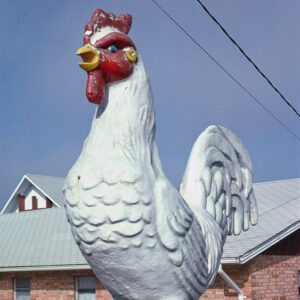 Chicken Statue
Chicken Statue  Cleveland Poultry Farm
Cleveland Poultry Farm 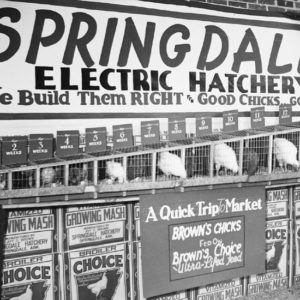 Rogers Broiler Show
Rogers Broiler Show  Harold Snyder
Harold Snyder 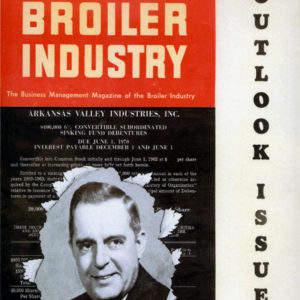 Harold Snyder
Harold Snyder  J. K. Southerland
J. K. Southerland 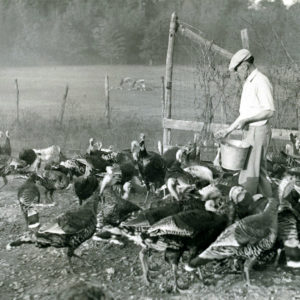 Turkey Farm
Turkey Farm  Tyson's Hatchery Air Delivery
Tyson's Hatchery Air Delivery 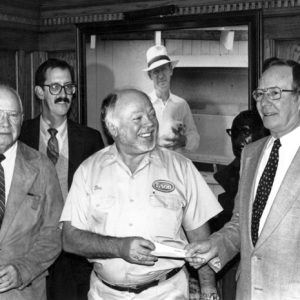 Don Tyson
Don Tyson 




Comments
No comments on this entry yet.